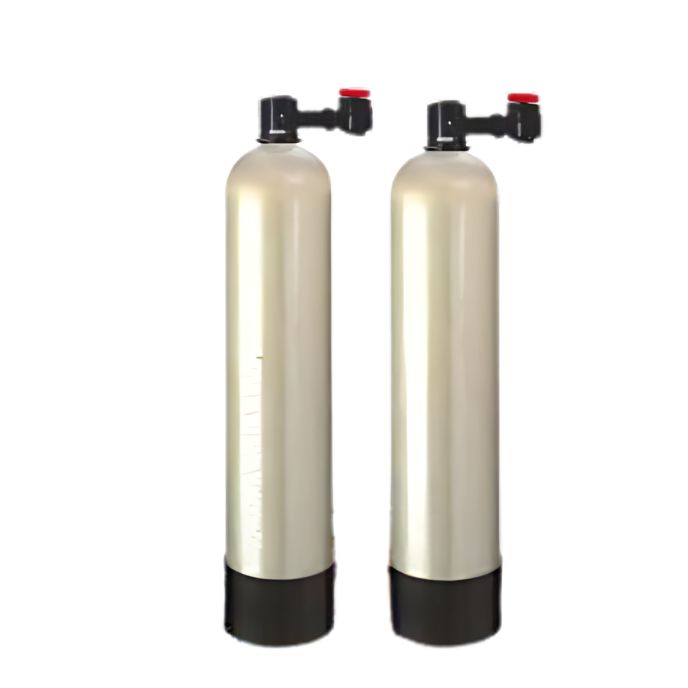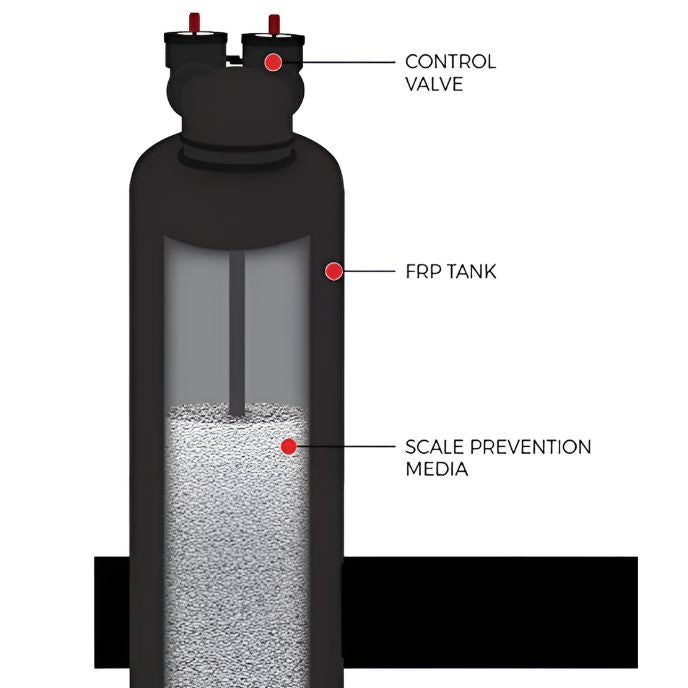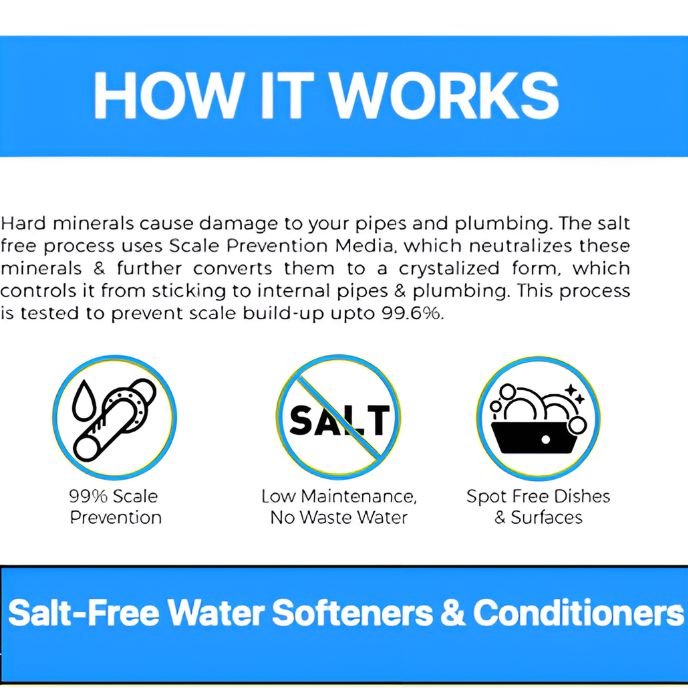Salt Free Water Conditioner with Scale Prevention | 15 GPM | & Catalytic Carbon Whole House Filtration System
- Regular price
-
$1,329.95 - Regular price
-
$1,350.00 - Sale price
-
$1,329.95
Couldn't load pickup availability
Salt Free Water Conditioner with Scale Prevention | 15 GPM | & Catalytic Carbon Whole House Filtration System
- NO chemicals or salt required!
- NO maintenance! NO drain required!
- Will not harm the environment; adds or removes nothing from the water while giving the benefits of soft water!
- Saves energy by eliminating the need to heat through insulating scale and save money by extending the life of pipes and appliances!
- The essential calcium and magnesium nutrients removed by traditional water softeners remain and there is no sodium added as with traditional softeners to aggravate cardiovascular or other health problems.
- 50% less soap and detergents required and enjoy whiter whites and brighter colors without hard water stains!
- Fits in limited space one small tank no brine tanks or large regeneration tanks!
How It Works
- Calcium ions, magnesium ions and bicarbonate ions in untreated water form scale on the inside walls of pipe, exterior of fixtures and on heating surfaces because crystallization is not taking effect efficiently between the ions due to their suspension between water molecules and the need to come together in the proper alignment to form crystals. Therefore they form as scale on the surfaces of the water system.
- The system is a simple “physical water treatment” known as TAC (Template Assisted Crystallization) Template=mold, guide or pattern. Assisted=Help or make easy. Crystallization=Form a definite shape.
- Inside the TAC treatment tank are porcelain beads with the atomic level pattern of the crystal etched on their surface allowing for the calcium, magnesium and bicarbonate ions to come together on the template to created millions of microscopic crystals of scale that rapidly form and are released from the bead immediately into the treated water, not forming on the contact surfaces of the water system and are carried downstream in suspension through the water system.
- The crystal formation on the microscopic crystals (seed crystals) created on the beads and released in the water stream are the lowest energy reaction possible between the ions therefore existing scale will be dissolved back into the water stream by reacting with and forming crystals.
- The seed crystals are constantly being formed on the beads and released as catalyst for crystal growth in the water steam.
- Crystallization is the process that the “magnet process” and “electrical charging of water” claim to achieve. But by independent testing the electrical and magnetic methods are a maximum of 60% effective at scale prevention leaving an unacceptable level of 40% scaling. The TAC method is tested at 99.9% efficient at scale prevention and removal.
KIT INCLUDES:
SCALE REDUCTION MEDIA
MINERAL TANK
DISTRIBUTOR ASSEMBLY
IN/OUT TANKHEAD
BY PASS VALVE
Carbon is a substance that has a long history of being used to absorb impurities and is perhaps the most powerful absorbent known to man. One pound of carbon contains a surface area of roughly 125 acres and can absorb literally thousands of different chemicals. Activated carbon which has a slight electro-positive charge added to it, making it even more attractive to chemicals and impurities.
In general, basic activated carbon itself has some catalytic activity due to the presence of a small number of chemical functionalities present on the corners of its graphitic basal plane. To enhance the catalytic activity of carbon, the surface is modified by a chemical process in which the electronic structure of the carbon is altered in such a manner that the resulting carbon offers enhanced catalytic capability.
As a result, the catalytic carbon produced by this method is not only rich in chemisorption, but also physisorption capacity.
Many water utilities across the U.S. are transitioning to chloramine for disinfection as an alternative to chlorine. This change is in response to stricter U.S. Environmental Protection Agency regulations on disinfection byproducts (DBPs), which are created when chlorine reacts with organics in water. Chloramine, a combination of chlorine and ammonia, is more stable and does not create DPBs.
Removing chloramine at the point of use, however, is more difficult than removing chlorine. Standard granular activated carbon (GAC) and carbon block products have limited capacity for chloramine reduction. Products known as “catalytic” or “surface-modified” activated carbon can provide a solution.
In general, the catalytic properties of carbon are measured by the rate at which carbon decomposes hydrogen peroxide. The resulting peroxide number, measured in minutes, estimates the carbon’s utility in any catalytic application, including chloramine reduction. Based on the comparative results obtained for different mesh size commercial carbons, the efficiency of chloramine reduction is discussed in the terms of peroxide decomposition capacity and further extended to the total life (volume) claims for corresponding GAC cartridge and carbon block.
The two most important factors affecting the efficiency of activated carbon filtration are the amount of carbon in the unit and the amount of time the contaminant spends in contact with it. the more carbon the better. Similarly, the lower the flow rate of the water, the more time contaminants will be in contact with the carbon, and the more absorption that will take place. Particle size also affects removal rates. The most common carbon types used in water filtration are bituminous, wood, and coconut shell carbons. While coconut shell carbon typically costs 20% more than the others, it is generally regarded as the most effective of the three. All of our activated carbon filters use coconut shell carbon.
9"x 48" Mineral Tank (Black or Blue)
Upflow ValveBy Pass Valve
Adapter Kit
Distribution Tube
Catalytic Carbon media 1 cu ft.
Up Flow systems direct the water in the up=flow direction of the system. The water comes into the water system tank and flows through an upper basket and then down a riser tube in the middle of the tank. Once the water reaches the bottom of the tank it is then distributed through a lower basket attached to riser tube. The water then flows from the bottom of the tank through the filter media in a swirling motion. The swirling motion is created by the reaction of the water coming out of the lower basket coming in contact with the bottom of the filter tank which is rounded or curved. A up-flow design eliminates the need for backwashing on most filters because the media is continuously being fluffed each time the water flows through the tank. Another advantage to an up-flow design is the amount of contact time the untreated water has with the filter media. An up-flow design also forces the filter media to which in turn allows the media to have longer contact time with the water yielding better results.
NO lime scale build-up on pipes, fixtures or appliances and can even remove existing scale in some cases! Easy Installation, Two Connections, Simple pipe in /pipe out!Saves water no backwash required simple flow through to point of use!NO power required NO timer or backwash cycle!




Salt Free Water Conditioner with Scale Prevention | 15 GPM | & Catalytic Carbon Whole House Filtration System
- Regular price
-
$1,329.95 - Regular price
-
$1,350.00 - Sale price
-
$1,329.95




